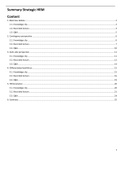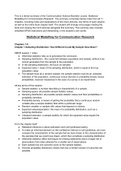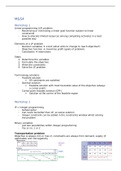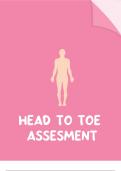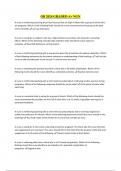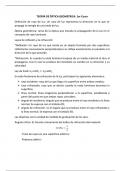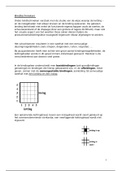Summary Strategic HRM
Content
1. Black box debate ................................................................................................................................................................. 2
1.1. Knowledge clip ............................................................................................................................................................. 2
1.2. Recorded lecture .......................................................................................................................................................... 3
1.3. Q&A .............................................................................................................................................................................. 5
2. Contingency perspective ..................................................................................................................................................... 6
2.1. Knowledge clip ............................................................................................................................................................. 6
2.2. Recorded lecture .......................................................................................................................................................... 7
2.3. Q&A ............................................................................................................................................................................ 10
3. Dark-side perspective ....................................................................................................................................................... 11
3.1. Knowledge clip ........................................................................................................................................................... 11
3.2. Recorded lecture ........................................................................................................................................................ 12
3.3. Q&A ............................................................................................................................................................................ 14
4. Differentiated workforce .................................................................................................................................................. 15
4.1. Knowledge clip ........................................................................................................................................................... 15
4.2. Recorded lecture ........................................................................................................................................................ 16
4.3. Q&A ............................................................................................................................................................................ 19
5. HR Devolution ................................................................................................................................................................... 20
5.1. Knowledge clip ........................................................................................................................................................... 20
5.2. Recorded lecture ........................................................................................................................................................ 21
5.3. Q&A ............................................................................................................................................................................ 24
6. Summary ........................................................................................................................................................................... 25
1
,1. Black box debate
1.1. Knowledge clip
Central to Strategic Human Resource Management is the idea that the adoption by organizations of a more ‘sophisticated’
set of HR practices covering key aspects of the management of people in the workplace has a positive impact on
organizational performance. The practices and policies involved cover a wide range of human resource functions in areas
such as recruitment and selection, training and development, performance management, pay and benefits, participation,
and communication. According to SHRM theory, the more these HR practices are implemented in an organization, the
better the organization’s performance.
However, our understanding of the processes by which HR practices affect organizational performance has been quite
limited. Indeed, it is unclear both how many steps there are in the link between HRM and performance, and what the
content of each step is. This has been referred to as the black box debate in Strategic Human Resource Management.
In response, there have been a number of efforts to model the impact of HRM on organizational performance. Central to
these models is the idea that employees play a key role in explaining the impact of HR practices on organizational
performance. Let us take a closer look at the question by discussing three theories that dominate the field of Strategic
Human Resource Management.
The first is the Resource-Based View of the Firm (RBV, developed by Barney in 1991). The main assumption of this theory
is that organizations can build a competitive advantage based on resources that are valuable (capable of delivering
superior competitive results), rare (not easily obtained by competitors), imperfectly imitable (hard to copy), and non-
substitutable (hard to replace). Organizations have different types of resources, including:
Organizational resources (e.g., structure, planning)
Physical resources (e.g., plants, equipment)
Human resources
Building upon this resource-based paradigm, Boxall proposes that a human resource advantage can consist of:
Human capital advantage – a situation where there is a stock of exceptional human talent working within the
organization, whose knowledge, abilities and skills match the strategic needs of the firm.
Human process advantage – the presence of difficult-to-imitate, historically evolved processes within the
organization, such as intense forms of co-operation between people.
As such, the RBV logic provides a rationale for how HR practices positively affect organizational performance by building
a better human capital pool and by stimulating better processes within the organization.
The second model is the AMO framework by Appelbaum and colleagues. This refers to the idea that people perform well
if they have the Ability, Motivation, and Opportunity to do so. Let’s take a look at the three components.
1. Ability means the employee can perform well on the job because he/she possess the necessary knowledge and
skills (this is linked to human capital theory). These, in turn, can be influenced by HR practices, for example by
providing training opportunities.
2. Motivation means employees perform well on the job because they want to perform well. HR practices such as
internal career opportunities and extensive rewards motive employees to perform well (this is linked to social
exchange theory).
3. The third component is having the opportunity to perform well. HR practices such as enabling employee
participation in decision-making can empower employees to show good performance.
In sum, the AMO provides a rationale for how HR practices impact organizational performance by increasing employees’
ability, motivation, and opportunity to produce high performance.
Finally, we have the HRM process model by Wright and Nishii. This model highlights the distinction between HR practices
that senior managers intend to implement in the organization, the practices that are actually implemented by line
2
, managers, and employees’ perceptions of these implemented practices. The model also explains why there is sometimes
a disconnect between the three. For example, line managers may fail to implement an intended HR practice because they
lack the time or skills to do so. Employees, for their part, may interpret the same practices in different ways because of
factors like their previous work experience. This model thus addresses the question of how HR practices impact
organizational performance by looking at how these practices are implemented in the workplace, and how employees
experience and respond to them.
We have discussed how HRM is related to organizational performance and explored the underlying processes according
to the Resource Based View, the AMO framework and the HRM process model. Based on these theories, we can conclude
that employees (or human resources) play a key role in explaining the impact of HR practices on organizational
performance.
1.2. Recorded lecture
There is a moderately strong positive relationship between
HRM and performance (operational and financial outcomes)
In search for the Holy Grail: unique ways of managing people
to gain organizational success
Recruitment and selection ability
Training and development ability
Performance management motivation
Pay and benefits motivation
Participation and communication opportunity
Black-box debate:
• How many boxes should be taken into account?
• What should be the content of each box?
Three theories dominate the SHRM field
1. Resource based view of the firm (Barney, 1991 / Boxall, 1996)
Is a resource (1) Valuable, (2) Rare, (3) Non-substitutable and (4) Inimitable:
a. Unique timing and learning
b. Social complexity
c. Causal ambiguity
Human resource advantage:
1. Human capital advantage (a stock of exceptional human talent)
2. Human process advantage (a function of difficult to imitate, historically evolved processes within the
organization, such as co-operation. E.g., nurses and doctors who work together to deliver a better service
to the patient).
The RBV logic provides a theoretical rationale for how HR practices positively affect organizational performance
through building a better human capital pool and stimulating better processes. However, research that tests the
RBV’s core concepts remains scarce (Wright, Dunford, & Snell, 2001; Becker & Huselid, 2006). Moreover, what
about the individual employee? It very focuses on the organization level.
2. AMO-framework (Appelbaum et al., 2000 / Jiang et al., 2012)
“…people perform well when:
• They are able (‘can’) to do so
• They have the motivation (are ‘willing’) to do so
3
Content
1. Black box debate ................................................................................................................................................................. 2
1.1. Knowledge clip ............................................................................................................................................................. 2
1.2. Recorded lecture .......................................................................................................................................................... 3
1.3. Q&A .............................................................................................................................................................................. 5
2. Contingency perspective ..................................................................................................................................................... 6
2.1. Knowledge clip ............................................................................................................................................................. 6
2.2. Recorded lecture .......................................................................................................................................................... 7
2.3. Q&A ............................................................................................................................................................................ 10
3. Dark-side perspective ....................................................................................................................................................... 11
3.1. Knowledge clip ........................................................................................................................................................... 11
3.2. Recorded lecture ........................................................................................................................................................ 12
3.3. Q&A ............................................................................................................................................................................ 14
4. Differentiated workforce .................................................................................................................................................. 15
4.1. Knowledge clip ........................................................................................................................................................... 15
4.2. Recorded lecture ........................................................................................................................................................ 16
4.3. Q&A ............................................................................................................................................................................ 19
5. HR Devolution ................................................................................................................................................................... 20
5.1. Knowledge clip ........................................................................................................................................................... 20
5.2. Recorded lecture ........................................................................................................................................................ 21
5.3. Q&A ............................................................................................................................................................................ 24
6. Summary ........................................................................................................................................................................... 25
1
,1. Black box debate
1.1. Knowledge clip
Central to Strategic Human Resource Management is the idea that the adoption by organizations of a more ‘sophisticated’
set of HR practices covering key aspects of the management of people in the workplace has a positive impact on
organizational performance. The practices and policies involved cover a wide range of human resource functions in areas
such as recruitment and selection, training and development, performance management, pay and benefits, participation,
and communication. According to SHRM theory, the more these HR practices are implemented in an organization, the
better the organization’s performance.
However, our understanding of the processes by which HR practices affect organizational performance has been quite
limited. Indeed, it is unclear both how many steps there are in the link between HRM and performance, and what the
content of each step is. This has been referred to as the black box debate in Strategic Human Resource Management.
In response, there have been a number of efforts to model the impact of HRM on organizational performance. Central to
these models is the idea that employees play a key role in explaining the impact of HR practices on organizational
performance. Let us take a closer look at the question by discussing three theories that dominate the field of Strategic
Human Resource Management.
The first is the Resource-Based View of the Firm (RBV, developed by Barney in 1991). The main assumption of this theory
is that organizations can build a competitive advantage based on resources that are valuable (capable of delivering
superior competitive results), rare (not easily obtained by competitors), imperfectly imitable (hard to copy), and non-
substitutable (hard to replace). Organizations have different types of resources, including:
Organizational resources (e.g., structure, planning)
Physical resources (e.g., plants, equipment)
Human resources
Building upon this resource-based paradigm, Boxall proposes that a human resource advantage can consist of:
Human capital advantage – a situation where there is a stock of exceptional human talent working within the
organization, whose knowledge, abilities and skills match the strategic needs of the firm.
Human process advantage – the presence of difficult-to-imitate, historically evolved processes within the
organization, such as intense forms of co-operation between people.
As such, the RBV logic provides a rationale for how HR practices positively affect organizational performance by building
a better human capital pool and by stimulating better processes within the organization.
The second model is the AMO framework by Appelbaum and colleagues. This refers to the idea that people perform well
if they have the Ability, Motivation, and Opportunity to do so. Let’s take a look at the three components.
1. Ability means the employee can perform well on the job because he/she possess the necessary knowledge and
skills (this is linked to human capital theory). These, in turn, can be influenced by HR practices, for example by
providing training opportunities.
2. Motivation means employees perform well on the job because they want to perform well. HR practices such as
internal career opportunities and extensive rewards motive employees to perform well (this is linked to social
exchange theory).
3. The third component is having the opportunity to perform well. HR practices such as enabling employee
participation in decision-making can empower employees to show good performance.
In sum, the AMO provides a rationale for how HR practices impact organizational performance by increasing employees’
ability, motivation, and opportunity to produce high performance.
Finally, we have the HRM process model by Wright and Nishii. This model highlights the distinction between HR practices
that senior managers intend to implement in the organization, the practices that are actually implemented by line
2
, managers, and employees’ perceptions of these implemented practices. The model also explains why there is sometimes
a disconnect between the three. For example, line managers may fail to implement an intended HR practice because they
lack the time or skills to do so. Employees, for their part, may interpret the same practices in different ways because of
factors like their previous work experience. This model thus addresses the question of how HR practices impact
organizational performance by looking at how these practices are implemented in the workplace, and how employees
experience and respond to them.
We have discussed how HRM is related to organizational performance and explored the underlying processes according
to the Resource Based View, the AMO framework and the HRM process model. Based on these theories, we can conclude
that employees (or human resources) play a key role in explaining the impact of HR practices on organizational
performance.
1.2. Recorded lecture
There is a moderately strong positive relationship between
HRM and performance (operational and financial outcomes)
In search for the Holy Grail: unique ways of managing people
to gain organizational success
Recruitment and selection ability
Training and development ability
Performance management motivation
Pay and benefits motivation
Participation and communication opportunity
Black-box debate:
• How many boxes should be taken into account?
• What should be the content of each box?
Three theories dominate the SHRM field
1. Resource based view of the firm (Barney, 1991 / Boxall, 1996)
Is a resource (1) Valuable, (2) Rare, (3) Non-substitutable and (4) Inimitable:
a. Unique timing and learning
b. Social complexity
c. Causal ambiguity
Human resource advantage:
1. Human capital advantage (a stock of exceptional human talent)
2. Human process advantage (a function of difficult to imitate, historically evolved processes within the
organization, such as co-operation. E.g., nurses and doctors who work together to deliver a better service
to the patient).
The RBV logic provides a theoretical rationale for how HR practices positively affect organizational performance
through building a better human capital pool and stimulating better processes. However, research that tests the
RBV’s core concepts remains scarce (Wright, Dunford, & Snell, 2001; Becker & Huselid, 2006). Moreover, what
about the individual employee? It very focuses on the organization level.
2. AMO-framework (Appelbaum et al., 2000 / Jiang et al., 2012)
“…people perform well when:
• They are able (‘can’) to do so
• They have the motivation (are ‘willing’) to do so
3


